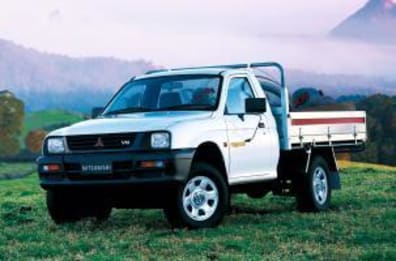
Used Mitsubishi Triton review: 1996-2006
- Mitsubishi Triton
- Mitsubishi Triton 2006
- Mitsubishi Triton 2003
- Mitsubishi Triton 1996
- Mitsubishi Triton 1997
- Mitsubishi Triton 1998
- Mitsubishi Triton 1999
- Mitsubishi Triton 2000
- Mitsubishi Triton 2001
- Mitsubishi Triton 2002
- Mitsubishi Triton 2004
- Mitsubishi Triton 2005
- Mitsubishi Triton Reviews
- Mitsubishi Reviews
- Mitsubishi Commercial Range
- Mitsubishi Ute Range
- Commercial
- Ute
- Mitsubishi
- Used Car Reviews
- Buying tips
- Tradies

They're still working-class vehicles, but they're now used as family transport and wagons for weekends in the bush or at the beach. The Mitsubishi Triton has been a fixture on the local scene for more than 20 years and has built a large and loyal following.
Model Watch
The fourth-generation MK Triton was replaced by the ML model in 2006, but until the ML came along it was the best Triton model that Mitsubishi had released. It is now the one being sought and bought by used-car buyers.
Compared with previous models the MK Triton was quite advanced and, despite its commercial underpinnings, was as car-like as you could get in a work ute. The Triton range was large with a choice of cab-chassis and ute styles, single cab, club-cab and dual-cab bodies, four-cylinder and V6 petrol engines, a four-cylinder diesel, and two and four-wheel drive.
On top of that, buyers could choose from GL, GLS and GLX depending on the level of equipment they wanted. The base engine was the 97kW 2.4-litre petrol engine that delivered good performance with good torque down low for pulling power. It was a popular choice of gardeners, landscapers, carpenters, plumbers and other tradies.
The 133kW 3.0-litre V6 was the best performer, but it came with a fuel economy penalty, a major factor when choosing a car. Both the petrol engines were LPG-compatible, which increased their appeal on the used market.
Initially the diesel engine was a naturally aspirated 2.8-litre unit that was economical but lacked performance. That was addressed in 2003 when Mitsubishi replaced it with a 2.8-litre turbo diesel.
Inside, the MK was clearly a member of an older generation and didn't have the room of the new ML. Rear seat room was particularly limited if you wanted it for family use. The seats were upright and uncomfortable.
The Triton had a 10-year lifespan so they now vary from old and worn-out to relatively new. With that long life they had a number of upgrades, the latest being the best and the ones to look for.
In The Shop
Because they have been used for many and varied tasks, it's important to find out as much as you can about your chosen vehicle. A working vehicle tends to get a much harder time than one used for transporting junior to soccer training at weekends.
Check in and around the tray for damage. There are almost always bangs and bumps from loads being tossed in and slung around. Heavy loads could have caused the suspension to sag so check the condition of springs and shocks.
Bodywork should be checked for damage. It easily gets knocked about on the worksite. Four-wheel-drives need to be checked for heavy off-road use. Generally, they're tough enough to survive moderate use with little to show for it, but if they've been subjected to consistent heavy off-road use you could expect to find damage underneath.
Look for battle scars caused by rocks on the body, exhaust and suspension. Generally the Triton is a tough vehicle and owners experience little trouble. Most problems are minor, such as engine oil leaks.
The Triton and other pickups don't have to meet the safety standards that apply to cars so there are generally less safety features built into them. The Triton was crash-tested and came up with a commendable three-star ANCAP rating. Only later models had airbags available.
At The Pump
Fuel consumption varies tremendously with pickups because of the variation in load, towing and operating conditions. But expect to get 11-12 litres for 100km for a four-cylinder model, and 13-15 litres for 100km for the V6. 4WDs will be higher. The most economical will be the diesel, but go for the later turbo diesel, which will deliver a better blend of performance and economy.
Pricing
| Year | Price From | Price To |
|---|---|---|
| 2006 | $3,410 | $15,950 |
| 2005 | $3,080 | $12,760 |
| 2004 | $2,860 | $9,020 |
| 2003 | $2,640 | $8,690 |
| 2002 | $1,930 | $8,690 |
| 2001 | $1,930 | $7,150 |
| 2000 | $2,200 | $7,150 |
| 1999 | $2,420 | $7,150 |
| 1998 | $2,420 | $7,150 |
| 1997 | $2,420 | $7,150 |
| 1996 | $2,310 | $7,150 |
Pricing guides
Range and Specs
| Vehicle | Specs | Price* | |
|---|---|---|---|
| STD (4X4) | 3.0L, ULP, 5 SP MAN 4X4 | $3,080 – 4,840 | 1996 Mitsubishi Triton 1996 STD (4X4) Pricing and Specs |
| (4X4) | 3.0L, ULP, 5 SP MAN 4X4 | $3,080 – 4,730 | 1996 Mitsubishi Triton 1996 (4X4) Pricing and Specs |
| GLX | 2.8L, Diesel, 5 SP MAN | $3,080 – 4,730 | 1996 Mitsubishi Triton 1996 GLX Pricing and Specs |
| Luxury (4x4) | 2.5L, Diesel, 5 SP MAN 4X4 | $3,190 – 5,060 | 1996 Mitsubishi Triton 1996 Luxury (4x4) Pricing and Specs |
$3,410
Lowest price, based on third party pricing data







